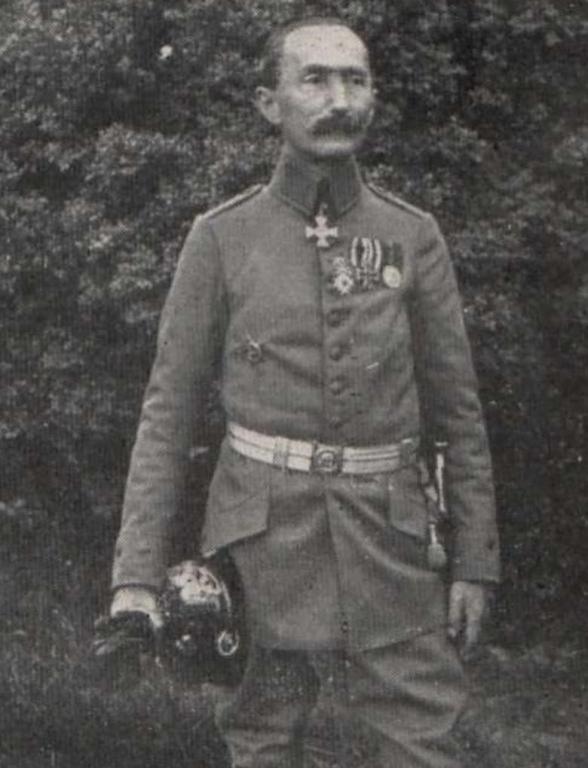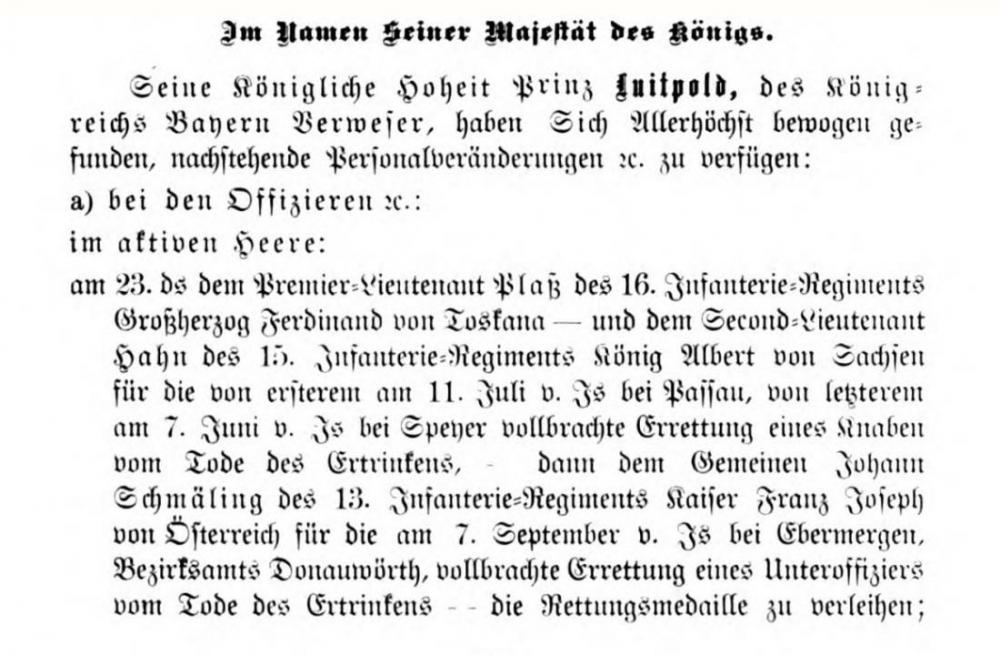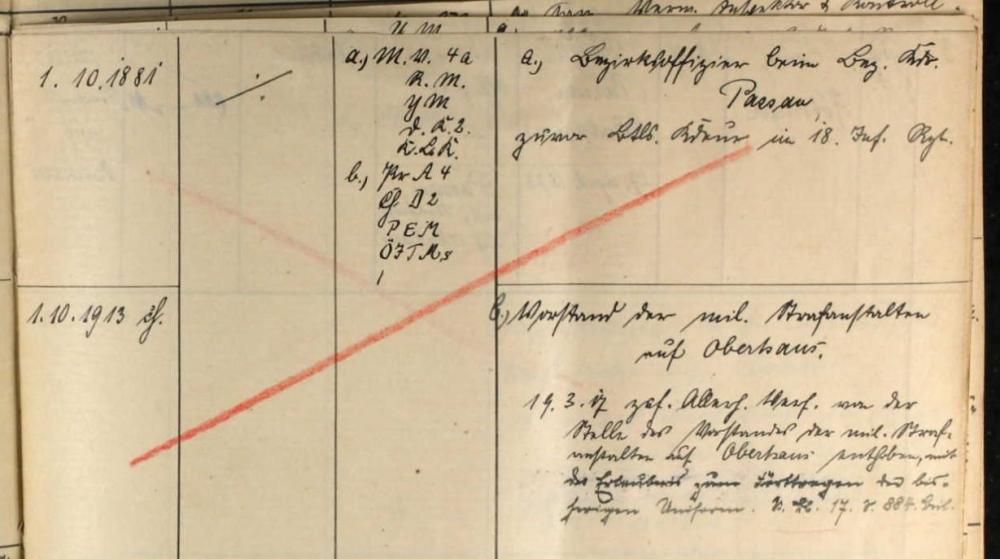-
Posts
4,908 -
Joined
-
Last visited
-
Days Won
97
Content Type
Profiles
Forums
Blogs
Gallery
Events
Store
Everything posted by Dave Danner
-
A little update on Lt.d.R. Alwin Zirkler from Sturm-Bataillon Rohr, mentioned several times in this thread and whose EK1 document Chris has shown. Alwin Friedrich Wilhelm Zirkler was born on 23.2.1889 in Saarbrücken. He was a Gerichtsreferendar in Trier. As a Kriegsfreiwilliger, he served in the Artillerie-Munitions-Kolonne 3 des VIII.Armeekorps, and later came to Pionier-Ersatz-Bataillon Nr. 7 as an Unteroffizier der Reserve before coming to the 4. Pionier-Kompanie of Sturm-Bataillon Rohr. In 1916 he was a Vizefeldwebel der Reserve and was promoted on 5.12.1916 to Leutnant der Reserve (Saarbrücken) of Infanterie-Regiment Nr. 112 (still serving in Sturm-Bataillon Rohr). I have no idea why he was commissioned in IR 112, let alone any infantry regiment, given he seems to have come from the pioneers. On 9.9.1917, he was wounded in an assault on Höhe 344 by Verdun. Besides the Iron Cross 1st Class, he received the Ritterkreuz mit Schwertern of the Königlich Hausorden von Hohenzollern (gazetted on 20.11.1917). After the war, he was a Gerichtsreferendar in Saarbrücken and was at some point promoted to Dr.jur. In the interwar-years, he was the Kommissarischer Führer des Stahlhelm-Bunds im Saargebiet. I cannot find a date of death, but there are a few other on-line mentions which show him as alive in the 1950s, so he may have also served in World War II. The full name and date of birth are from the Saarbrücken birth register. Most of the details of his wartime service are from the Militär-Wochenblatt, the Verlustlisten, and the Kriegslisten of the Münchener Burschenschaft Rhenania.
-
He was the father of television pioneer Dr.-Ing. Rudolf Urtel. According to the younger Urtel's biography here, Urtel "mußte durch den frühen Tod seines Vaters sein Jura-Studium abbrechen und nahm 1928 eine Stelle im Telefunken-Röhrenvertrieb an". I can't find a date of death for the elder Urtel, but this indicates it was around 1928.
- 7 replies
-
- prussia
- kraftfahr-bataillon
-
(and 1 more)
Tagged with:
-
1. EK2 2. Fürstlich Reußisches Ehrenkreuz 3. Klasse mit der Krone und Schwertern 3. probably Mecklenburg-Schwerinsches Militärverdienstkreuz 2. Klasse 4. HH 5. LüH 6. BremH 7. ?? He was an Ordonnanz-Offizier in the IX. Reservekorps, which accounts for the various Hanseatic and Mecklenburg awards. I assume 3 is the MMV2 and not the Strelitz cross, which had the same ribbon, because he is not in the Strelitz roll and we are missing many late war Schwerin awards which were not published in the Regierungsblatt. The 1919 KR 2 Stammliste only lists Hamburg, Lübeck and Reuß among his wartime non-Prussian awards. I have no idea what the last one is. It might be Finnish, but he is not in the Ostsee-Division officer list and he's not Navy, so I don't know of any connection between him and the Finnish campaign.
-

Turkey Photos of the Ottomans and Allies decorated with the TWM
Dave Danner replied to demir's topic in Türkiye
Kaiserlich Geheimer Regierungsrat (Resident in Kigali, Ruanda) and Bavarian Stabsarzt der Reserve Dr. Richard Kandt, born 17. December 1867 in Posen, died 29. April 1918 in Reserve-Lazarett Nürnberg as a result of a gas attack at the front. He served from 15 March to 15 June 1915 with the Ottoman 4th Army. -
The Schaumburg-Lippe Kreuz für treue Dienste was awarded on 19.6.1917. According to the Hof- und Staatshandbuch des Königreichs Bayern and the Bayerisches Gesetz- und Verordnungsblatt, he received the Verdienstorden vom Heiligen Michael 4. Klasse in 1888. The statutes for the order were revised in 1910, upgrading this to the version with the crown. I have no information about his service record, but I would agree with your conclusions about the Prussian/German service medals.
-

The Medal of Honor outside the USA
Dave Danner replied to Elmar Lang's topic in United States of America
Many United States laws have extraterritorial application. These range from laws against genocide and war crimes and laws relating to recovery for torts by immigrants and refugees when the torts occurred in other countries to various tax laws and the like. The existence of these laws is a matter of fact. As a practical matter, enforcement of such laws can be difficult, since that often requires the cooperation of foreign law enforcement agencies and judicial and political authorities, and there are also often evidentiary issues (getting depositions or testimony from foreign parties, for example). Of course, all international law is as a practical matter subject to the cooperation or coercion of the parties, sometimes by meetings, sometimes by tanks. By the way, extraterritoriality is not unique to the U.S. Other countries also purport to apply certain laws outside their own jurisdictions, and face the same practical issues. The ban on "Nazi" items on fora like eBay, for example, began because of efforts by France and Germany to apply their own laws on Nazi propaganda not just to yahoo.fr or ebay.de, but to the entire global enterprises. -
Here is the link to the Dresden death certificates: https://www.ancestry.com/interactive/9153/42636_6425_1942023-00211?pid=23148555&treeid=&personid=&rc=&usePUB=true&_phsrc=DbM2609&_phstart=successSource That is US-based Ancestry.com. Assuming you have an account, you'd probably need to change the top level domain to the Australian equivalent.
- 18 replies
-
- iron cross
- husar
-
(and 3 more)
Tagged with:
-
Linienschiffskapitän Artur Müldner was an Austrian/Austro-Hungarian naval officer. He is listed as a See-Cadet in the 1863 Militär-Schematismus, so I assume he was born sometime in the mid-1840s. The decorations listed are: • Order of the Iron Crown, 3rd Class (1893) • Military Merit Medal • War Medal • Commemorative Medal for the 1864 Campaign against Denmark • 1898 Jubilee Medal for the Armed Forces • Military Service Decoration for Officers, 3rd Class He disappears from the Austro-Hungarian Court and State Handbook and the Schematismus for the Army and Navy between the 1906 and 1907 editions of each of those reference books, so I would assume he died then.
-
I'd have to agree with Don. This was likely from the 1913 Kaiser Maneuvers. I included a few photos from that set of maneuvers when I created the Wikipedia page on the Imperial German Army back in 2007. I am surprised that one of them is still there (https://commons.wikimedia.org/wiki/File:HusarenAngriff.jpg). The photos were taken from the book Deutschlands Wehrmacht, published in 1913. I don't have my copy handy, so I don't know if Chris's picture is also in the book, but the details like terrain and picture quality and dimensions are similar.
-
The number is a "0" with a little curlicue at the top. He died on 20.1.1948, according to his death certificate. The death certificate says that he was born in Pommlitz, Kreis Döbeln, not Leipzig (Pommlitz is now a suburb of the city of Döbeln). The uniform in the 1912-dated photo should be that of Ulanen-Regiment Nr. 18. That was his regiment before being sent to command the Militärreitanstalt in Dresden in 1909. Then-Rittmeister Müller was sent to replace the commander of that institute on 15.2.1909, when the commander was on temporary duty elsewhere. He was officially transferred there on 22.5.1909 as the temporary commander (mit der Wahrnehmung der Geschäfte beauftragt), and was named commander on 23.5.1910 when he was promoted to Major. He remained in command there until the war began, receiving a Patent as Major on 1.10.1912. He was on the staff of Armee-Oberkommando 3 (High Command of the 3rd Army) when he received the Swords to his Knight 1st Class with Crown of the Albrechts-Orden. Other than that, and your reference to him being the commander of that command's Hauptquartier, I don't have any information on him from mobilization in August 1914 until he took command of HR 19 on 6.7.1915. He was promoted to Oberstleutnant on 30.11.1917, retired on 31.3.1920, and was given the Charakter of Oberst on 30.7.1920. After HR 19 was disbanded, he commanded Kavallerie-Regiment 19 of the provisional Reichswehr from May 1919 to April 1920. Christophe, one error in your list of dates. He received the Crown to his Knight 1st Class of the Albrechts-Orden in July 1914, not 1907.
- 18 replies
-
- iron cross
- husar
-
(and 3 more)
Tagged with:
-

The Swiss Iron Cross
Dave Danner replied to Chris Boonzaier's topic in Germany: All Eras: The Iron Cross
I believe that Austrians from the Innviertel were eligible to serve in the Bavarian Army because Bavaria never really accepted its annexation by Austria. It had belonged to Bavaria since the Middle Ages until 1779 when ceded to Austria, was regained in 1809, and then ceded to Austria again in 1815. You get hundreds of results on Ancestry if you search the Bavarian records for Braunau and Schärding, two of the districts of the Austrian Innkreis. You get a lot more results for Ried, but that's because there are Bavarian towns named Ried not part of Ried im Innkreis. -
Walter Seebohm had the Österreich-Ungarisches Militärverdienstkreuz 3. Klasse mit der Kriegsdekoration 3. Klasse, so the ribbon bar does not match him. There might be some other double-Waldeck possibilities. I started cross-checking Rick and Daniel's published list but gave up because there were too many NCOs with only a last name in the rolls, so you could not be sure if Lt.d.R. XXX with the Verdienstkreuz was also Vfw.d.R. XXX with the Verdienstmedaille. One possibility is Wolrad Köhler from IR 32, born in Landau in Waldeck. He received the SMK on 4.6.1917 and the WVK4X on 22.8.1917. He was a law student at Philipps-Universität in Marburg a.d. Lahn before and after the war, so if he became a lawyer, he might have been a Beamter in the 1930s/40s. There are a bunch of Köhlers who received the Waldeck gold or silver Verdienstmedaille mit Schwertern, but without a first name. And there are several Leutnants d.R. Köhler with the HOH3X who have yet to be identified.
-
Schwarzschild was an Unteroffizier des Landsturms when the war started. He joined the military weather service as a Kriegsfreiwilliger and deployed to the Western Front on 10 September 1914 as leader of a field weather station in Namur. He soon began research in other areas, and presented a paper to the Prussian Academy of Sciences on 8 November 1915 entitled "Über den Einfluß von Wind und Luftdichte auf die Geschoßbahn" ("On the influence of wind and air density on the ballistic trajectory"). He was in the meantime transferred to the artillery. He served on higher artillery commands on the Western and Eastern Fronts studying ballistic matters, and was awarded the Iron Cross 2nd Class. He also continued his research into Einstein's theories and presented three more papers to the Academy of Sciences in 1916. In March 1916, he left the field for health reasons and died two months later, with his final paper being published the same day he died. Sources: Zeitschrift der Deutschen Gesellschaft für Mechanik Jahresbericht der Deutschen Mathematiker-Vereinigung
-
The only Karabinier-Regiment officers I know of with the Friedrichkreuz are: • Erich Bardenwerper, *3.1.1887 in Dessau, gef. 31.3.1916; Lt.d.R. d. KarabR, kdrt. z. Fliegertr. • Ernst Guenther, *7.8.1896 in Dessau; Lt., KarabR, OLt.a.D. If it is Bardenwerper, those are his only known decorations. If it is Guenther, the photo would have to be between 15.7.1915, when he received the AK, and 28.10.15, when he received the SA3bX. Guenther received his GSF3bX in 1915, but there are no exact dates in the rolls. Below is Guenther in Finland in 1918. There does seem to be some similarity. The image is from this thread:
-
Yes, this of from the Kriegsranglisten/Kriegsstammrollen on Ancestry (Rangliste for officers, Stammrolle for enlisted). Regarding the Inhaber-Jubiläumsmedaille, he was transferred to the 13.IR on 31.10.1898. In the 1901 rank list, Plaß is a Hptm. à l.s. d. 13.IR and Mitglied der Militär-Schießschule, commanded to the Prussian Gewehr-Prüfungskommission. Generally, non-Prussians and non-veterans who received the Kaiser-Wilhelm-Gedächtnismedaille fell into three categories: (1) they were in units stationed in the Reichsland Elsaß-Lothringen, (2) the Chef/Inhaber of their regiment was the Kaiser, or (3) they were commanded to a Prussian formation (commands, units, schools, etc.) at the time of the award. Neither of the first two apply to Plaß, since he was in the 11th company of the 16. Infanterie-Regiment in Passau in 1897, whose Inhaber was Grand Duke Ferdinand of Tuscany. No Kommandierung is shown in the 1897 rank list or mentioned in the 1897 Verodrnungsblatt. The only mention of Plaß in the 1896 Verordnungsblatt relates to the Rettungsmedaille (VOBl. v. 30. January 1896):
-
Lt.d.R. Conrad Ehrlich, *11.11.1889 in Dresden, was killed in action on 15.3.1917 in Macedonia. He was a Prussian officer, however. He was promoted to Lt.d.R. (Hagen i.W.) in Reserve-Jäger-Bataillon Nr. 7 on 14.7.1915, and was killed in action while serving with Radfahr-Bataillon Nr. 4. He received the Schaumburg-Lippe Kreuz für Treue Dienste on 23.9.1915.
-
Meister was a Prussian officer. This Luftwaffe officer has either the Jubilee Medal of the Bavarian Army with Crown or the Prinzregent-Luitpold Medal with Crown, which means he was a Bavarian officer and served in the 1. Feldartillerie-Regiment. You'd think that would make him relatively easy to narrow down (how many Bavarian officers became Luftwaffe generals and how many were in the 1.FAR by at least 1911?).
-
His only prewar decoration would appear to be the 1897 Centenary Medal. There is a good chance he would have received the Dienstauszeichnungskreuz für Offiziere for 25 years' service around 1919-20, when many Prussian officers received that belated award (Prussia delayed awards of the DA to officers during the war itself). Given how many years he spent in IR 76 before the war, there is a good chance that if he was nominated for the Hamburg Hanseatenkreuz, it would have been approved.




